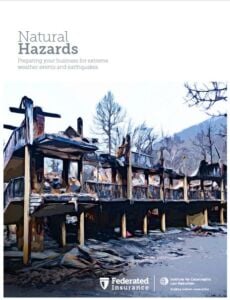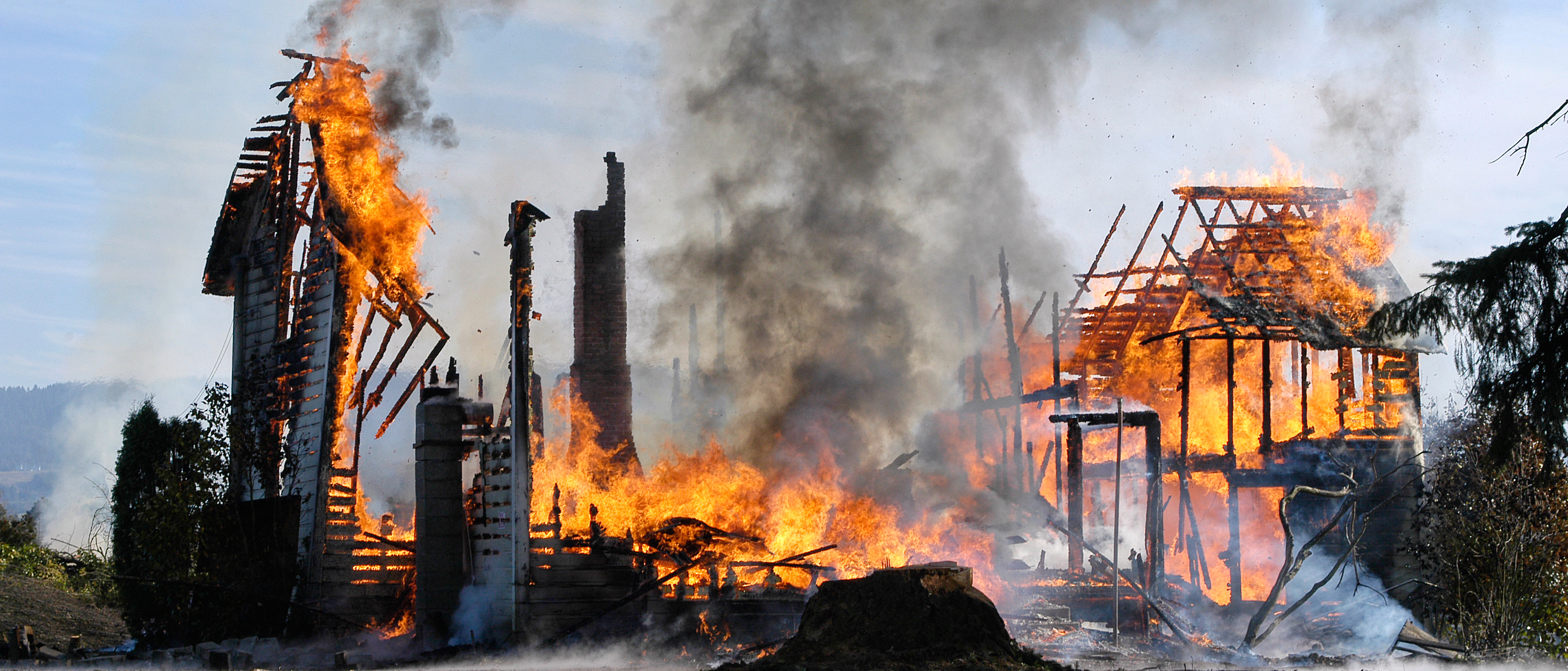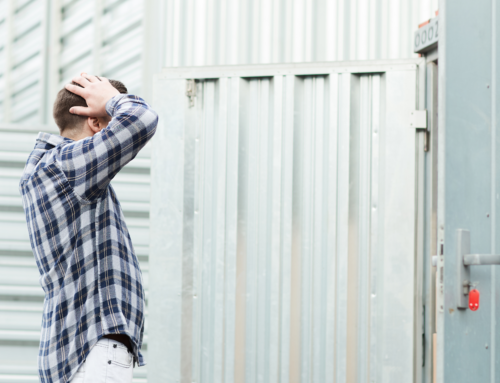Natural hazards cause billions of dollars of damage in Canada every year. The cost is expected to increase with the impacts of climate change — and no business or industry is immune.
With an increase in natural hazards, there’s a need to develop proactive solutions to increase awareness of the risks, build long-term resiliency, and prevent or mitigate losses. That’s why it’s vital to be educated on the different types of natural hazards so you can prepare for them.
We partnered with the Institute for Catastrophic Loss Reduction (ICLR) to write a whitepaper on preparing your business for extreme weather events. Download it here.
Types of extreme weather events and tips on how to prepare for them
Wildfires
Wildfires are a natural occurrence in Canada, thanks to our many forested and grassland regions. Typically, wildfires occur from early spring through fall, and each year about 8,000 wildfires burn across 2.5 million hectares of land in Canada.
To help protect your property, experts suggest that you monitor your local news, stay up to date on weather developments, and check weather alerts frequently. Natural Resources Canada offers the Canadian Wildland Fire Information System with daily fire weather and fire behaviour maps, as well as hot spot maps, throughout the duration of the forest fire season. Federal, provincial, and territorial governments also provide up-to-date reports on the fire situation across Canada via the Canadian Interagency Forest Fire Centre.
Fire safety checklist
Create a safety zone: Follow National Fire Protection Association (NFPA) standards and maintain at minimum a 10-metre separation between buildings (as well as vehicles, fuel tanks, and outside storage areas) and high grass or wooded areas. If trees in this area are primarily coniferous (such as pine and fir), this zone should be expanded to at least 30 metres.
Provide a safe smoking area: Some wildfires are caused by an easily preventable accident, such as a cigarette butt that wasn’t properly extinguished. Establish a safe outdoor smoking area and provide appropriate containers for discarding smoking materials.
Store combustibles: Store combustible and flammable materials in approved containers at an acceptable distance from buildings, fences, and vehicles. Consult your local authorities for specific laws and requirements.
Floods
Canada is surrounded by three oceans and has more lakes than any other country in the world, including four of the Great Lakes, so it’s no surprise the country is prone to flooding. Flash flooding, which occurs when the ground can’t absorb the water quickly enough, can be caused by violent storms or torrential downpours. Flash flooding is unanticipated and there’s usually little time to prepare.
Water damage makes up most of the catastrophic losses in Canada, according to the IBC. That’s why a flood plan should be part of your business continuity plan. Understanding your risks and being proactive can help to mitigate losses related to water damage and flooding.
Flood protection checklist:
- Make sure that employees know what to do in the event of a flood. As part of your flood plan, identify evacuation routes and organize emergency drills for staff.
- Install backflow prevention check valves in basements or lower levels of properties to stop floodwater from entering at vulnerable points where utility and sewer lines enter the facility.
- Install permanent sump pumps with backup power supplies.
- Seal walls to prevent or reduce seepage and, if necessary, reinforce walls to resist water pressure.
- Ensure your business is adequately insured for flood damage. Property damage, business interruption, and liability insurance are critical coverages if your business is to bounce back. Keep in mind, surface flooding and sewer flooding are two different perils and require two different insurance coverages.
Ice, snow, and winter storms
Canada has one of the most severe winter climates in the world. A big winter storm could knock out electricity, heat, and communications for hours, even days, as evidenced by the devastating 1998 ice storm in central and eastern Canada. Climate change is expected to make these winter storms more frequent and intense.
As part of your business continuity plan, here are some points to consider:
Prepare for power ou
Prevent frozen pipes: Accidental bursting of plumbing pipes is common during extreme cold — and the damage can be costly. Indeed, frozen pipes are a leading source of property damage during severe winter weather, according to the Insurance Institute for Business & Home Safety (IBHS). To reduce risks, seal all windows, doors, and wall cracks on exterior walls with caulk or insulation, and insulate and seal partition walls, vents, plumbing stacks, and electric and mechanical chases.
Windstorms, tornadoes, and hurricanes
Canada experiences all types of extreme wind events, from violent windstorms to tornadoes and hurricanes. Violent winds are often a component of natural hazards, causing power outages and damage to roofs and properties — and turning loose items into dangerous projectiles.
In Canada, tornado season typically runs between March and October, with activity peaking in late June or early July. Environment Canada is responsible for warning the public about potential tornadoes, but not all tornadoes come with warning signs — meaning you may need to react quickly.
A hurricane is a tropical storm with a minimum wind speed of 120 km/h. Hurricanes tend to cause more widespread damage than tornadoes because they’re much larger, sometimes stretching 1,000 kilometres, and storm surges can cause widespread coastal flooding.
Be prepared
You can help reduce damage to your property from tornadoes and other wind-related weather events by taking simple precautions, such as performing routine maintenance. For example, inspect and repair loose or damaged building components such as siding, shingles, roofing, and brickwork, and remove trees and branches that could fall on the roof or on power lines.
If you’re building, rebuilding, or renovating, consider retrofitting your property and/or replacing your roof. Retrofitting could include bracing and strapping the roof; adding fasteners, ties, and reinforcements; and installing doors that are pressure and impact rated. Choose wind- and hail-rated shingles for your roof (a wind rating is the force of wind required to blow the shingle off the roof). And if you have a gable roof, make sure it’s properly braced.
Hail
Property owners have experienced hundreds of millions of dollars in hail damage over the past 25 years. The Calgary hailstorm of 2020 alone cost at least $1.3 billion in insurance claims.
Hail protection checklist:
- When re-roofing, install a full roof underlayment, preferably a self-adhering waterproofing underlayment (also referred to as an ice-and-water shield).
- Use roofing products with the Underwriters Laboratories UL 2218 Class 4 impact resistance rating.
- Use brick cladding or fiber cement board siding in place of aluminum or vinyl.
- Place a specially designed cage around rooftop A/C units on commercial and industrial buildings that are vulnerable to damage from strong winds.
- Whenever possible, keep vehicles parked under permanent cover, such as a garage or carport.
Earthquakes
Canada experiences up to 5,000 earthquakes each year, though most of them are small and undetectable without special equipment. However, they can strike suddenly, without warning, and occur at any time of year.
When building, rebuilding, or renovating in an earthquake zone, consider construction design and materials that can resist earthquake forces:
Windows and glass doors: If you’re replacing your windows, consider tempered glass, which is designed to break into small pieces that are far less likely to injure anyone. Another option is to install a protective film (4 mm minimum thickness) on the inside of the windows.
Cripple walls: Cripple walls are short wood-frame walls situated between the foundation of the building and the first-floor framing. Strengthen the cripple wall so that it and the foundation behave more like a single unit.
Masonry walls: A building with walls made entirely of brick, stone, clay tile, concrete block, or adobe could be susceptible to earthquake damage. If the walls are reinforced and well anchored to the foundation, floor, and roof, they can usually withstand an earthquake.
Building foundations: Buildings that are not properly attached to the foundation can shift during an earthquake. A building should be connected to the foundation with anchor bolts or other steel connectors (including anchors, steel plates, or straps) that secure the sill plate to the foundation.
Ensure you’re covered
Despite your best efforts and preparation, you could still fall victim to damages as a result of a natural hazard. That’s why it’s important to invest in comprehensive coverage. Learn more by visiting our Business Insurance page today!
This blog is provided for information only and is not a substitute for professional advice. We make no representations or warranties regarding the accuracy or completeness of the information and will not be responsible for any loss arising out of reliance on the information.


